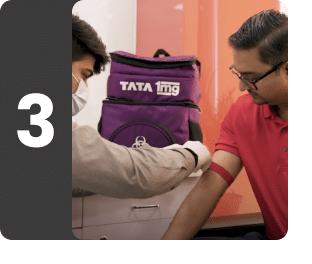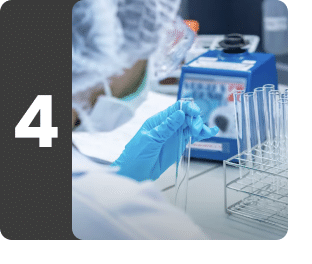Antenatal Profile Comprehensive near me in Noida
Understanding Antenatal Profile Comprehensive in Noida
What is Antenatal Profile Comprehensive in Noida?
Antenatal Profile Comprehensive is a unique package tailored to assess the overall health, blood group, and important infections like HIV, syphilis, and hepatitis B & C in pregnant females as these can be transmitted from the mother to her child. The HIV antigen/antibody test simultaneously detects HIV p24 antigen and HIV (1&2) antibodies and can usually detect HIV infection within 18 to 45 days after exposure. The HBsAg test detects the surface antigen specific to hepatitis B. HCV antibody detects the exposure to hepatitis C. Hb-HPLC helps to diagnose thalassemia, sickle cell disease, and other hemoglobin disorders. This package also offers important tests, including blood sugar (fasting), TSH, CBC, and urine examination, that help detect possible health concerns in a pregnant woman to ensure a healthy pregnancy.
What does Antenatal Profile Comprehensive measure?
Contains 41 testsHIV Combo (Antigen And Antibody) Test

CBC (Complete Blood Count)
A CBC (Complete Blood Count) test evaluates red blood cells (RBCs), white blood cells (WBCs}, and platelets. Each of these blood cells performs essential functions–RBCs carry oxygen from your lungs to the various body parts, WBCs help fight infections and other diseases, and platelets help your blood to clot–so determining their levels can provide significant health information. A CBC test also determines the hemoglobin level, a protein in RBC that carries oxygen from the lungs to the rest of your body. Evaluating all these components together can provide important information about your overall health.
Know more about CBC (Complete Blood Count)
Absolute Lymphocyte Count
-
T lymphocytes (T cells): T cells control your body’s immune system response and directly attack and kill infected cells and tumor cells.
-
B lymphocytes (B cells): B cells make antibodies. Antibodies are proteins that target viruses, bacteria, and other foreign pathogens.
An Absolute Lymphocyte Count test measures the total number of lymphocytes in the blood. Lymphocytes are a type of white blood cells that play an important role in your immune system and help your body fight disease and infection. There are two main types of lymphocytes:
Lymphocytes help your immune system remember every antigen (a foreign substance) it comes in contact with. After an encounter, some lymphocytes turn into memory cells. When these memory cells run into an antigen again, they recognize it and quickly respond. It is also the reason why getting vaccinated helps prevent certain diseases.
Absolute Neutrophil Count
An Absolute Neutrophil Count test measures the percentage of neutrophils per microliter of blood. Neutrophils are a type of WBC and play an integral part in the body's immune system. They help fight off bacterial infections in the body by identifying and destroying foreign invaders, such as disease-causing microorganisms.
Differential leukocyte Count
- Differential Neutrophil Count
- Differential Lymphocyte Count
- Differential Monocyte Count
- Differential Eosinophil Count
- Differential Basophil Count
There are five types of WBCs: neutrophils, lymphocytes, monocytes, eosinophils, and basophils. A Differential leukocyte Count test measures the percentage of each type of WBC in the blood. Leukocytes or WBCs are produced in the bone marrow and defend the body against infections and diseases. Each type of WBC plays a unique role to protect against infections and is present in different numbers.
This further contains
Red Blood Cell Count
A Red Blood Cell Count test measures the total number of red blood cells in your blood. RBCs are the most abundant cells in the blood with an average lifespan of 120 days. These cells are produced in the bone marrow and destroyed in the spleen or liver. Their primary function is to help carry oxygen from the lungs to different body parts. The normal range of RBC count can vary depending on age, gender, and the equipment and methods used for testing.
Hb (Hemoglobin)
A Hb (Hemoglobin) test measures the concentration of hemoglobin protein in your blood. Hemoglobin is made up of iron and globulin proteins. It is an essential part of RBCs and is critical for oxygen transfer from the lungs to all body tissues. Most blood cells, including RBCs, are produced regularly in your bone marrow. The Hb test is a fundamental part of a complete blood count (CBC) and is used to monitor blood health, diagnose various blood disorders, and assess your response to treatments if needed.
Platelet Count
A Platelet Count test measures the average number of platelets in the blood. Platelets are disk-shaped tiny cells originating from large cells known as megakaryocytes, which are found in the bone marrow. After the platelets are formed, they are released into the blood circulation. Their average life span is 7-10 days.
Platelets help stop the bleeding, whenever there is an injury or trauma to a tissue or blood vessel, by adhering and accumulating at the injury site and releasing chemical compounds that stimulate the gathering of more platelets. A loose platelet plug is formed at the site of injury and this process is known as primary hemostasis. These activated platelets support the coagulation pathway that involves a series of steps, including the sequential activation of clotting factors; this process is known as secondary hemostasis. After this step, there is a formation of fibrin strands that form a mesh incorporated into and around the platelet plug. This mesh strengthens and stabilizes the blood clot so that it remains in place until the injury heals. After healing, other factors come into play and break the clot down so that it gets removed. In case the platelets are not sufficient in number or not functioning properly, a stable clot might not form. These unstable clots can result in an increased risk of excessive bleeding.
Total Leukocyte Count
A Total Leukocyte Count test measures the numbers of all types of leukocytes, namely neutrophil, lymphocyte, monocyte, eosinophil, and basophil, in your blood. Leukocytes or WBCs are an essential part of our immune system. These cells are produced in the bone marrow and defend the body against infections and diseases. Each type of WBC plays a unique role to protect against infections and is present in different numbers.
Absolute Basophil Count
An Absolute Basophil Count test measures the total number of basophils in the blood. Basophils are small, spherically-shaped cells that originate from bone marrow and make up almost 1% of the total white blood cells in the body. They attack a foreign substance and release proteins like histamine and heparin to destroy harmful substances, such as allergens, pathogens, or parasites. Histamine helps widen the blood vessels and make space for more immune cells to come to the site of infection or injury, whereas heparin acts as a blood-thinning agent and helps to avoid blood clotting at that site.
Absolute Monocyte Count
An Absolute Monocyte Count test measures the total number of monocytes in the blood. Monocytes are a type of WBC that originate from bone marrow and travel to different tissues via the blood. Once they are inside the tissue, these cells get converted to macrophages (a type of cell that digest harmful substances). Monocytes are the second line of defense mechanism of the human body after neutrophils. These cells are also responsible for the removal of injured or dead cells, microorganisms, and other insoluble particles from the blood.
Absolute Eosinophil Count
An Absolute Eosinophil Count test measures the number of eosinophils in the blood and provides important information about the functioning of the immune system. Eosinophils originate from bone marrow and have a lifespan of 8-18 hours. These cells are involved in fighting certain types of infections and responding to allergic reactions in the body. The eosinophils have varied functions including the physiological role in organ formation, such as the development of post-gestational mammary glands. Other functions of these cells include movement to the inflammation areas, trapping substances, killing cells, and bactericidal and antiparasitic activities. They also help in the treatment of immediate allergic reactions and modulation of inflammatory responses. By measuring the number of eosinophils in the blood, this test provides important information about the functioning of the immune system.
Hematocrit
A Hematocrit test measures the proportion of red blood cells (RBCs) in your blood as a percentage of the total blood volume. It is a crucial part of a complete blood count (CBC) and helps in assessing your blood health. RBCs are responsible for carrying oxygen from the lungs to different parts of the body. The hematocrit test provides valuable information about your blood's oxygen-carrying capacity.
Higher-than-normal amounts of RBCs produced by the bone marrow can cause the hematocrit to increase, leading to increased blood density and slow blood flow. On the other hand, lower-than-normal hematocrit can be caused by low production of RBCs, reduced lifespan of RBCs in circulation, or excessive bleeding, leading to a reduced amount of oxygen being transported by RBCs. Monitoring your hematocrit levels is essential for diagnosing and managing various blood-related disorders.
Mean Corpuscular Volume
A Mean Corpuscular Volume test measures the average size of your red blood cells, which carry oxygen through your body. This test tells whether your RBCs are uniform or vary significantly in size.
Mean Corpuscular Hemoglobin
An MCH test measures the average amount of hemoglobin in a single red blood cell (RBC). Hemoglobin is an iron-containing protein in RBCs, and its major function is to transport oxygen from the lungs to all body parts. This test provides information about how much oxygen is being delivered to the body by a certain number of RBCs.
Mean Corpuscular Hemoglobin Concentration
An MCHC test measures the average amount of hemoglobin in a given volume of RBCs. MCHC is calculated by dividing the amount of hemoglobin by hematocrit (volume of blood made up of RBCs) and then multiplying it by 100.
Mean Platelet Volume
An MPV test measures the average size of the platelets in your blood. Platelets are disk-shaped tiny cells originating from large cells known as megakaryocytes, which are found in the bone marrow. After the platelets are formed, they are released into the blood circulation. Their average life span is 7-10 days.
Platelets help stop bleeding whenever there is an injury or trauma to a tissue or blood vessel by adhering and accumulating at the injury site, and by releasing chemical compounds that stimulate the gathering of more platelets. After these steps, a loose platelet plug is formed at the site of injury, and this process is known as primary hemostasis. These activated platelets support the coagulation pathway that involves a series of steps including the sequential activation of clotting factors; this process is known as secondary hemostasis. After this, there is a formation of fibrin strands that form a mesh incorporated into and around the platelet plug. This mesh strengthens and stabilizes the blood clot so that it remains in place until the injury heals. After healing, other factors come into play and break the clot down so that it gets removed. In case the platelets are not sufficient in number or are not functioning properly, a stable clot might not form. These unstable clots can result in an increased risk of excessive bleeding.
PDW
RDW CV

Urine R/M (Urine Routine & Microscopy)
A Urine R/M (Urine Routine & Microscopy) test involves gross, chemical, and microscopic evaluation of the urine sample.
-
Gross examination: It involves the visual examination of the urine sample for color and appearance. Normally, the urine color ranges from colorless or pale yellow to deep amber, depending on the urine’s concentration. Things such as medications, supplements, and some foods such as beetroot can affect the color of your urine. However, unusual urine color can also be a sign of disease.
In appearance, the urine sample may be clear or cloudy. A clear appearance is indicative of healthy urine. However, the presence of red blood cells, white blood cells, bacteria, etc. may result in cloudy urine, indicating conditions such as dehydration, UTIs, kidney stones, etc. Some other factors such as sperm and skin cells may also result in a cloudy appearance but are harmless.
-
Chemical examination: It examines the chemical nature of the urine sample using special test strips called dipsticks. These test strips are dipped into the urine sample and they change color when they come in contact with specific substances. The degree of color change gives an estimate of the amount of the substance present. Some of the common things detected include protein, urine pH, ketones, glucose, specific gravity, blood, nitrites, and urobilinogen among others.
-
Microscopic examination: It involves the examination of the urine sample under the microscope for casts, crystals, cells, bacteria, and yeast.
Know more about Urine R/M (Urine Routine & Microscopy)
Urobilinogen
Ketone
Nitrite
Colour
Appearance
Specific Gravity
Epithelial Cell
Casts
Crystals
Protein Urine
Ph for Urine
Urine Glucose

Blood Group ABO & RH Factor Test
A Blood Group ABO & RH Factor Test detects the presence of antigens (A, B & Rh) on the surface of RBCs to determine your blood group and antigen type.
Know more about Blood Group ABO & RH Factor Test
Hepatitis B Surface Antigen, Serum

TSH (Thyroid Stimulating Hormone) Ultrasensitive
A TSH (Thyroid Stimulating Hormone) Ultrasensitive test measures the levels of TSH hormone in the blood. TSH is produced by the pituitary gland located in the brain. Its function is to stimulate and regulate the functioning of the thyroid gland. It signals the thyroid gland to increase or decrease the production of thyroid hormones T3 and T4 (essential for regulating our body’s metabolism, temperature, heart rate, and growth) when their levels are low or high, respectively. Therefore, when the levels of T3 & T4 decrease, the pituitary gland is stimulated to release TSH. This high TSH level in turn stimulates the thyroid gland to release more thyroid hormones (T3 & T4); the vice-versa happens when the levels of thyroid hormones increase.
Know more about TSH (Thyroid Stimulating Hormone) Ultrasensitive

FBS (Fasting Blood Sugar)
A fasting blood sugar test measures the level of glucose in the body under overnight fasting conditions. Glucose serves as the energy currency of the body and is broken down through metabolism to produce energy. This process is controlled by hormones and enzymes in organs such as the liver and pancreas. The hormone insulin, produced by the pancreas, is responsible for regulating blood glucose levels. When these levels are high, such as after a meal, insulin is secreted to transport glucose into cells for energy production. Elevated glucose levels in the body after fasting may indicate a risk of developing prediabetes or diabetes, which can be of two types- Type 1, caused by little or no insulin production, and Type 2, caused by insulin resistance or decreased insulin production.
Know more about FBS (Fasting Blood Sugar)
Hb HPLC (Hb Variants Estimation by HPLC)
VDRL; RPR (Rapid Plasma Reagin)
Hepatitis C Virus Antibody, CMIA/CLIA
Book a Antenatal Profile Comprehensive test at home near me





Other tests









